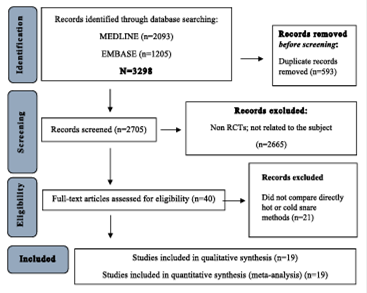ABSTRACT – Background –
Colorectal cancer is the third most common cancer, and prevention relies on screening programs with resection complete resection of neoplastic lesions. Objective – We aimed to evaluate the best snare polypectomy technique for colorectal lesions up to 10 mm, focusing on complete resection rate, and adverse events. Methods – A comprehensive search using electronic databases was conducted to identify randomized controlled trials comparing hot versus cold snare resection for polyps sized up to 10 mm, and following PRISMA guidelines, a meta-analysis was performed. Outcomes included complete resection rate, en bloc resection rate, polypectomy, procedure times, immediate, delayed bleeding, and perforation. Results – Nineteen RCTs involving 8720 patients and 17588 polyps were included. Hot snare polypectomy showed a higher complete resection rate (RD, 0.02; 95%CI [+0.00,0.04]; P=0.03; I2=63%), but also a higher rate of delayed bleeding (RD 0.00; 95%CI [0.00, 0.01]; P=0.01; I2=0%), and severe delayed bleeding (RD 0.00; 95%CI [0.00, 0.00]; P=0.04; I2=0%). Cold Snare was associated with shorter polypectomy time (MD -46.89 seconds; 95%CI [-62.99, -30.79]; P<0.00001; I2=90%) and shorter total colonoscopy time (MD -7.17 minutes; 95%CI [-9.10, -5.25]; P<0.00001; I2=41%). No significant differences were observed in en bloc resection rate or immediate bleeding. Conclusion – Hot snare polypectomy presents a slightly higher complete resection rate, but, as it is associated with a longer procedure time and a higher rate of delayed bleeding compared to Cold Snare, it cannot be recommended as the gold standard approach. Individual analysis and personal experience should be considered when selecting the best approach. Keywords – Cancer; colorectal; polyps; polypectomy; colonoscopy; colon.
AUTORES
Paulo Ricardo Pavanatto CAVASSOLA, Diogo Turiani Hourneaux de MOURA, Bruno Salomão HIRSCH, Davi Lucena LANDIM, Wanderley Marques BERNARDO and Eduardo Guimarães Hourneaux de MOURA*


